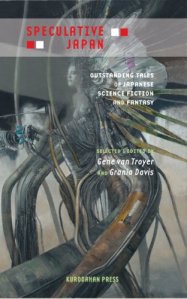 |
“Where Do the Birds Fly Now” (novelette) by Koichi Yamano
First published in Hayakawa SF Magazine (February 1971) Currently available from Kurodahan Press’s Speculative Japan (2007) |
| Original: Japanese, 1971 Translated by Dana Lewis, 2007 |
Synopsis: The sight and flight of birds are often taken for granted, but one man’s interest is piqued when he experiences birds swooping in front of his face, but no one else shares his vision. Further, it seems that they are a figment of his mind but not his imagination. With each swoop, the man’s reality is altered along parallel universes. Deep in the forest, he meets a self-described “bird watcher” who knows of the trans-dimensional birds.
Analysis: The man in the story had always had birds flying “in front of his face” but they were actually trans-dimensional birds affecting his mind. Each time one of the birds swoops, the man’s reality is altered slightly to that of an alternate timeline; one bird is a small timeline change while a flock of the birds shifts his timeline drastically. However, the man hadn’t learned of this seemingly idiosyncratic phenomenon until late in his life even though the birds had always swooped. So, unknowingly to this man, his reality shifted time and time again yet he didn’t know that the reality he was experiencing wasn’t the same reality from where he originated.
That’s a pretty heavy statement: He never knew his reality was changing; He unknowingly lived each day in a different parallel universe; He could never be the same man as he had begun. This shows in the man’s resultant complacency when he learns the truth from the so-called bird watcher. The simple sparrows of trans-dimensional flight, which alter the man’s reality, swoop and flock with cause. The bird watcher knows: What happens to the bygone realities? To and from, where do the birds fly? What is their mode of existence?
The man’s experience seems to be unique, aside from the bird watcher’s inclusion. Why are they the only two to discover their altering perceptions of reality by cause of the birds? It’s not as if his old reality is forgotten about; he can pick up a newspaper and see minor differences from his old reality: “Janis Joplin releases third album → Janis Joplin dies suddenly” (107). Unfortunately, he cannot control this changes, he cannot generate a more idealistic reality to counter instances of past regret.
One major event that changes his perspective, and the onset for the story, is one of death and fire. Viewing the mayhem with Noriko, a bird swoops; the following day, his companion, Noriko, couldn’t recall the event of death and fire. Eventually, Noriko disappears from his reality. Barring Noriko’s inability to recall the event, some events in our lives seem to have no catalyst for change, no impetus for a shift in our daily lives, no cause for the result, no why for the altered now. How many times has someone just dropped from your life without a word, never to be heard from again? Two words, two proper nouns, one name: Alison Mayfield. It happened to me when I was only 15 years old. I must have been living in a bubble universe because no one else knew her—her and I existed on one plane of reality then she suddenly shifted from my timeline; gone forever; no causation.
Tracking down causation for change is an ancient human endeavor and is more often than not granted to the power of the gods. Here in “Where Do the Birds Fly Now”, this agent of change isn’t a supernatural god, but trans-dimensional birds whose plan/flight/flocking is just as mysterious as the causation for so many of our daily struggles with change.